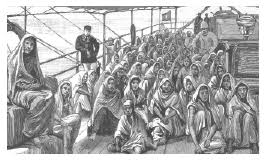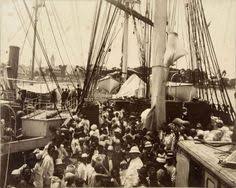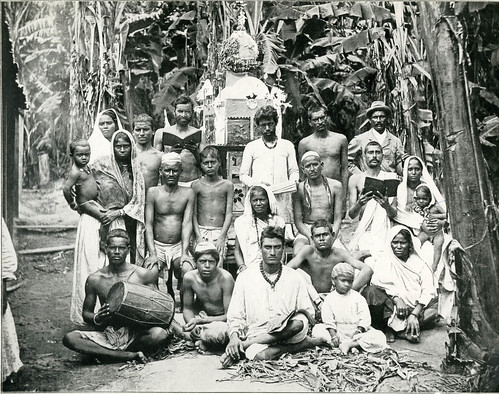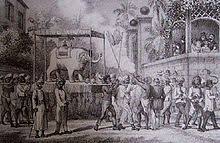www.swahainternational.org
 The Arrival of East Indians In Guyana | Horizons Guyana
The Arrival of East Indians In Guyana | Horizons Guyana
We
have defintiely come a very long way from our days of indentured labour
and cane farming. The now generation does not face the challenge of
highlighting
www.horizonsguyana.com
 Finally, a memorial to honour India's indentured workers | Indian Link
Finally, a memorial to honour India's indentured workers | Indian Link
May
5th, 2006 commemorates the 168th Anniversary of the arrival of East
Indian indentured immigrants in Guyana the former colony of British
Guiana .
www.indianlink.com.au
 East to West Indian heritage on Pinterest | Trinidad, Indian and ...
East to West Indian heritage on Pinterest | Trinidad, Indian and ...
Finally
a memorial will be inaugurated in Kolkata on Jan 11 to honour the
millions of Indian indentured workers who were taken to work in
plantations in the ...
www.pinterest.com
The second indentured servants in Suriname were the Indians. They arrived with the ship Lala
In 1879, an Englishman visiting an estate in Central
Trinidad (Felicity) wrote of the children of indentured immigrants
resident in the barracks; "The Co-olie is generally a creature with
little or no sense of personal hygiene, but his children are positively
filthy little urchins. They reek of excrement and urine, and their
oil-soaked locks are teeming with lice and ticks. Few bathe daily, and
they are left uneducated although there is a Co-olie school in the town."
BELOW-
Trinidad & Global News, Trinidad Express, Trinidad News, Trinidad ...

East Indian indentured labourers quarantined at Nelson Island,
Trinidad; more photos are available at Trinidad National Archives.
 Historiography of the West Indies on Flipboard
Historiography of the West Indies on Flipboard
www.southafrica.indiantimes.co.za
 Coolie - Wikipedia, the free encyclopedia
Coolie - Wikipedia, the free encyclopedia
First of Two Parts
Mahendra Sukhdeo –
The repugnant ‘slave trade’ from Black Africa to the newly settled White America ended in 1833. From 1500 AD, of the 12 million, about 10 million reached the American shores as slaves.
The Trans-Atlantic slavery based on human ownership was an unconscionable act of human trafficking, an abominable saga of European colonisation.
Coolie Trade
The Indian indenture system evolved on the back of the slave trade. One of the more enduring legacies of the British rule in India was its deliberate decision to export human cargo to distant European colonial outposts to meet their demand for cheap workforce.
A band of enlightened liberals in India and England, a string of colonial commission reports and the emerging Indian nationalistic public opinion ensured that disturbing inhuman deprivations that characterised the slave trade did not apply to the indenture system.
Mauritian success
The success of Indian labour utilisation in Mauritius from 1834 to 1900 opened the doors for planters in other countries to seek such labourers.
Mauritius had the largest component of 453,000 Indian migrants
followed by British Guiana with 239,000 from 1838-1916 and Trinidad with
144,000 from 1845-1916.
Fiji was fourth amongst the colonies with 61,000 from 1879 to 1916.
By the end of the indenture system in 1916, a band of over a million indentured labourers became the nucleus of the Indian Diasporas in the recipient countries.
Early Girmit
During the earlier period of Indian indenture (1830s to 1860s), most of the recruits were from Bihar as reflected in the Indian population of Mauritius, Guiana, Trinidad, and Suriname. From 1870s, there was a significant shift of migrant source to the west of Bihar towards the United Provinces as reflected predominantly in the Indian component of Fiji’s population.
Dark Shadows
While the Indian indenture was more enlightened than the slave trade, the excesses and inhuman treatment crept into Fiji.
This was typified by British Guiana’s private absentee land estate of John Gladstone (a Liverpool merchant and father of erstwhile liberal Prime Minister of Great Britain).
In July 1837, it received consignments of coolies, privately recruited in Bengal. Of the 396 emigrants shipped to the Gladstone Estate, only 22 were women.
This was the kind of practice that led to enforced polyandry.
Concerning areas
Broadly, there were four principal areas of concern. These were the rubbery, commission- based recruitment process anchored on the ‘arkatis’ (unlicensed agents), inadequacies of the shipping system, gender imbalance, application of the unilateral agreement (Girmit), inhuman treatment meted to the Girmitiyas and their rights to permanent settlement.
The colonial planters shared and paid for the Emigration Agents in India.
The arkatis were the last in the chain of agents. These agents coalesced and designed their strategies to recruit the gullible peasants caught in the web of push factors such as famine, draught, unemployment, indebtedness, poverty and familial/spousal disputes.
Incorrect perception
It is therefore wrong to place the entire blame on the arkatis and their questionable tactics.
The swan song of the Girmitiyas that they were the victims of the mechanisations of the arkatis was more often incorrect.
Journey from the up country holding depots such as Allahabad, Gorakhpur and Varanasi to Calcutta was long and lonely and sometimes abuses were hurled at both the agents and the recruits for the slavery that awaited the innocent rural folks.
At the pre-boarding depots at 15 Garden Reach Road, the peasants experienced for the first time the intermingling of caste and religious groups. Shipping schedules led some of them to wait for two to three months and cherry-picked for a colony that was not their destination. Most of them would leave the port never to return to their motherland.
The Black Sea
A more treacherous and sweltering sea journey spanning from 30 to 73 days awaited the recruits from Calcutta and later from Madras.
A combination of sail and steam ships (40 of them) made 87 voyages starting with ‘Leonidas’ that sailed into Fiji waters on May 14, 1879 with several lives lost to cholera and smallpox.
Paradoxically, Fiji Indians appeared to suffer from a jinx with the potent date of May 14.
Five years later, on May 14, 1884, the survivors of the Syria wreck were quarantined at Nukulau, near Suva and on May 14, 1987, Colonel Rebuke’s first coup wrote the final epitaph on the entrepreneurial and political aspirations of the Fiji Indians and heralded coup culture in Fiji.
Mahendra Sukhdeo is the author of ‘Aryan Avatars,’ which analyses the significant elements of the Indenture scheme and concludes that it was prematurely discontinued that precluded a larger proportion of poverty-stricken peasants of rural India from settling in virgin colonial outposts. An Elphinstonian from Bombay University, Mr Sukhdeo is a third generation Indo-Fijian whose grandparents were indentured in Fiji in early 1900. He lives in Melbourne, Australia.
Next Issue: The Syria Tragedy and fragility of the female genre
We salute Indo-Fijians on the occasion of the 136th anniversary of the arrival of the first batch of Indians from India under the infamous indenture labour system. Please read our Editorial, ‘Remembering the grim dark days in Fiji’ under Viewlink on Page 14.
The Indian community in South Africa: how it began
en.wikipedia.org
 Indian Indentureship
Indian Indentureship
Hindu festival for the indentured Indian workers, on the French colony Réunion.
www.guyanatimesinternational.com
From
the 1860s to the abolition of indenture in 1917, Indians comprised the
hulk of the immigrant work force. They were indentured for five years
but were required to serve for ten
Painful passage that led to untold miseries
Mahendra Sukhdeo –
The repugnant ‘slave trade’ from Black Africa to the newly settled White America ended in 1833. From 1500 AD, of the 12 million, about 10 million reached the American shores as slaves.
The Trans-Atlantic slavery based on human ownership was an unconscionable act of human trafficking, an abominable saga of European colonisation.
Coolie Trade
The Indian indenture system evolved on the back of the slave trade. One of the more enduring legacies of the British rule in India was its deliberate decision to export human cargo to distant European colonial outposts to meet their demand for cheap workforce.
A band of enlightened liberals in India and England, a string of colonial commission reports and the emerging Indian nationalistic public opinion ensured that disturbing inhuman deprivations that characterised the slave trade did not apply to the indenture system.
Mauritian success
The success of Indian labour utilisation in Mauritius from 1834 to 1900 opened the doors for planters in other countries to seek such labourers.
Fiji was fourth amongst the colonies with 61,000 from 1879 to 1916.
By the end of the indenture system in 1916, a band of over a million indentured labourers became the nucleus of the Indian Diasporas in the recipient countries.
Early Girmit
During the earlier period of Indian indenture (1830s to 1860s), most of the recruits were from Bihar as reflected in the Indian population of Mauritius, Guiana, Trinidad, and Suriname. From 1870s, there was a significant shift of migrant source to the west of Bihar towards the United Provinces as reflected predominantly in the Indian component of Fiji’s population.
Dark Shadows
While the Indian indenture was more enlightened than the slave trade, the excesses and inhuman treatment crept into Fiji.
This was typified by British Guiana’s private absentee land estate of John Gladstone (a Liverpool merchant and father of erstwhile liberal Prime Minister of Great Britain).
In July 1837, it received consignments of coolies, privately recruited in Bengal. Of the 396 emigrants shipped to the Gladstone Estate, only 22 were women.
This was the kind of practice that led to enforced polyandry.
Concerning areas
Broadly, there were four principal areas of concern. These were the rubbery, commission- based recruitment process anchored on the ‘arkatis’ (unlicensed agents), inadequacies of the shipping system, gender imbalance, application of the unilateral agreement (Girmit), inhuman treatment meted to the Girmitiyas and their rights to permanent settlement.
The colonial planters shared and paid for the Emigration Agents in India.
The arkatis were the last in the chain of agents. These agents coalesced and designed their strategies to recruit the gullible peasants caught in the web of push factors such as famine, draught, unemployment, indebtedness, poverty and familial/spousal disputes.
Incorrect perception
It is therefore wrong to place the entire blame on the arkatis and their questionable tactics.
The swan song of the Girmitiyas that they were the victims of the mechanisations of the arkatis was more often incorrect.
Journey from the up country holding depots such as Allahabad, Gorakhpur and Varanasi to Calcutta was long and lonely and sometimes abuses were hurled at both the agents and the recruits for the slavery that awaited the innocent rural folks.
At the pre-boarding depots at 15 Garden Reach Road, the peasants experienced for the first time the intermingling of caste and religious groups. Shipping schedules led some of them to wait for two to three months and cherry-picked for a colony that was not their destination. Most of them would leave the port never to return to their motherland.
The Black Sea
A more treacherous and sweltering sea journey spanning from 30 to 73 days awaited the recruits from Calcutta and later from Madras.
A combination of sail and steam ships (40 of them) made 87 voyages starting with ‘Leonidas’ that sailed into Fiji waters on May 14, 1879 with several lives lost to cholera and smallpox.
Paradoxically, Fiji Indians appeared to suffer from a jinx with the potent date of May 14.
Five years later, on May 14, 1884, the survivors of the Syria wreck were quarantined at Nukulau, near Suva and on May 14, 1987, Colonel Rebuke’s first coup wrote the final epitaph on the entrepreneurial and political aspirations of the Fiji Indians and heralded coup culture in Fiji.
Mahendra Sukhdeo is the author of ‘Aryan Avatars,’ which analyses the significant elements of the Indenture scheme and concludes that it was prematurely discontinued that precluded a larger proportion of poverty-stricken peasants of rural India from settling in virgin colonial outposts. An Elphinstonian from Bombay University, Mr Sukhdeo is a third generation Indo-Fijian whose grandparents were indentured in Fiji in early 1900. He lives in Melbourne, Australia.
Next Issue: The Syria Tragedy and fragility of the female genre
We salute Indo-Fijians on the occasion of the 136th anniversary of the arrival of the first batch of Indians from India under the infamous indenture labour system. Please read our Editorial, ‘Remembering the grim dark days in Fiji’ under Viewlink on Page 14.
